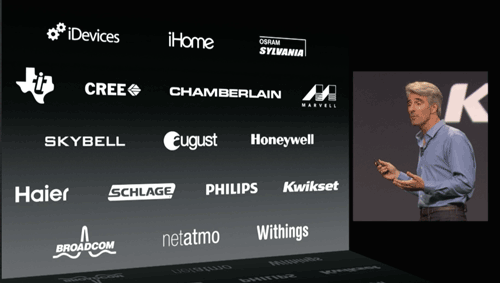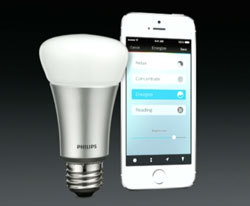[Translation] The Home Kit Framework - Learn more about Apple's home automation protocol.
Hello! I want to share the translation of the article , interesting for many people who are fond of smart home systems and Apple lovers.

When home automation began in 1996, only a handful of smart home systems existed — nor did they work together. But things do not stand still. Currently there are hundreds of smart home systems - which also do not work with each other.
')
Every week, smart home systems appear on Kickstarter. It seems that everyone in the industry wants to invent their own bike.
Over the years, we often wondered what would happen if Apple transferred its famous user experience to smart home systems.
You can no longer guess. Having previously mentioned in the main report at WWDC, this fall Apple announces the presence of “HomeKit” in iOS 8 firmware and from the preliminary documentation we can find out the following:
Thus, instead of simply providing a touch interface to our smart homes, Apple effectively uses the iOS device as an automation hub on your system.
The prefix i is not for red word here. This is not just an iOS or iPhone, this is Integration ...
As follows from the documentation, HomeKit includes basic functions, such as “detect”, and this allows third-party applications to perform three basic actions ...
Siri control is another important feature. In the past, entire computers along with sound mixers and microphone networks in the house tried to create something that is very easy to do today with a smartphone.
According to the developer’s documentation, the HomeKit data hierarchy looks like this:

We hope to learn more about HomeKit in the near future, as well as see what kind of equipment Apple partners will offer. Is it possible that Apple’s move will be enough to get the whole industry after the general protocol?
Or closeness and lack of support for other operating systems will mean that HomeKit will join many other standards that were before it?

When home automation began in 1996, only a handful of smart home systems existed — nor did they work together. But things do not stand still. Currently there are hundreds of smart home systems - which also do not work with each other.
')
Every week, smart home systems appear on Kickstarter. It seems that everyone in the industry wants to invent their own bike.
Over the years, we often wondered what would happen if Apple transferred its famous user experience to smart home systems.
You can no longer guess. Having previously mentioned in the main report at WWDC, this fall Apple announces the presence of “HomeKit” in iOS 8 firmware and from the preliminary documentation we can find out the following:
HomeKit is a new format for communicating and managing connected devices in the user's home. The program can give users the ability to detect devices in the house and their settings, as well as the ability to specify actions to control these devices. Users can group actions together and trigger them with Siri.
Thus, instead of simply providing a touch interface to our smart homes, Apple effectively uses the iOS device as an automation hub on your system.
The prefix i is not for red word here. This is not just an iOS or iPhone, this is Integration ...
HomeKit provides seamless integration between devices that support the Home Automation Protocol and Apple's iOS devices, opening up new opportunities in home automation. By promoting a common protocol for home automation devices and by making a public API available for setting up and interacting with these devices, HomeKit makes it possible for a market where home control applications do not depend on the supplier who makes home automation devices, and where these devices are from manufacturers can be integrated into a whole without sellers who need to cooperate directly with each other.
As follows from the documentation, HomeKit includes basic functions, such as “detect”, and this allows third-party applications to perform three basic actions ...
- Detect devices and add them to the cross-device home configuration database;
- Show, edit and perform actions with data in the home configuration database;
- Interact with customized devices and services to perform actions, such as turning on lights in a living room.
Siri control is another important feature. In the past, entire computers along with sound mixers and microphone networks in the house tried to create something that is very easy to do today with a smartphone.
For example, you can say Siri: “I'm going to sleep,” and this will dim the lights, close the doors of the house and the garage, and install a thermostat.
According to the developer’s documentation, the HomeKit data hierarchy looks like this:
Houses (HMHome) are a top-level container and are a structure that the user usually sees as one house. Users may have several houses that are far apart, for example, the main house and the country house. Or they may have two houses that are located close to each other, but are treated as different houses, for example, the main house and the guest house in the same area.
Rooms (HMRoom) are optional parts of the house and are separate rooms in the house. Rooms do not have physical characteristics: size, location, etc. They are simply names that are understandable to the user, such as "living room" or "kitchen." Room names are used in commands, such as, for example, “Siri, turn on the lights in the kitchen.”
Devices (HMAccessory) are installed in homes and attached to rooms. These are real physical home automation devices, such as an automatic garage door. If the user has not set up rooms, HomeKit binds the device to a special default room.
Service (HMService) - the actual functions that the device performs. The device has both user-controlled functions, such as, for example, light, as well as its own functions, for example, the firmware update service. HomeKit mainly works with the functions that users control. One device may be responsible for several user functions. For example, most automatic garage doors have a function for opening and closing a door, as well as a function to turn on the light.
Zones (HMZone) - this is an optional grouping of rooms in the house. "Upstairs" and "below" can be represented as separate zones. Zones are exclusively additional in nature - the rooms do not have to be included in them. By adding rooms to the zone, the user can give commands to Siri, such as: “Siri, turn on all the lights below.”

We hope to learn more about HomeKit in the near future, as well as see what kind of equipment Apple partners will offer. Is it possible that Apple’s move will be enough to get the whole industry after the general protocol?
Or closeness and lack of support for other operating systems will mean that HomeKit will join many other standards that were before it?
Source: https://habr.com/ru/post/242887/
All Articles
